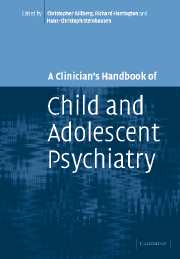Book contents
- Frontmatter
- Contents
- Preface
- List of contributors
- 1 Brain disorders
- 2 Substance use disorders
- 3 Schizophrenia and schizophrenia-like disorders
- 4 Affective disorders
- 5 Anxiety disorders
- 6 Obsessive-compulsive disorders
- 7 Adjustment disorders
- 8 Post-traumatic stress disorder
- 9 Functional somatic symptoms and somatoform disorders in children
- 10 Eating disorders: anorexia nervosa and bulimia nervosa
- 11 Sleep disorders
- 12 Personality disorders
- 13 Mental retardation/learning disability
- 14 Specific developmental disorders of speech and language
- 15 Reading and other learning disorders
- 16 Autism spectrum disorders
- 17 Hyperkinetic disorders
- 18 Conduct disorders
- 19 Elective mutism
- 20 Attachment and disorders of attachment
- 21 Tic disorders
- 22 Elimination disorders: enuresis and encopresis
- 23 Physical and sexual abuse
- 24 Gender identity disorders
- Index
- References
15 - Reading and other learning disorders
Published online by Cambridge University Press: 06 August 2009
- Frontmatter
- Contents
- Preface
- List of contributors
- 1 Brain disorders
- 2 Substance use disorders
- 3 Schizophrenia and schizophrenia-like disorders
- 4 Affective disorders
- 5 Anxiety disorders
- 6 Obsessive-compulsive disorders
- 7 Adjustment disorders
- 8 Post-traumatic stress disorder
- 9 Functional somatic symptoms and somatoform disorders in children
- 10 Eating disorders: anorexia nervosa and bulimia nervosa
- 11 Sleep disorders
- 12 Personality disorders
- 13 Mental retardation/learning disability
- 14 Specific developmental disorders of speech and language
- 15 Reading and other learning disorders
- 16 Autism spectrum disorders
- 17 Hyperkinetic disorders
- 18 Conduct disorders
- 19 Elective mutism
- 20 Attachment and disorders of attachment
- 21 Tic disorders
- 22 Elimination disorders: enuresis and encopresis
- 23 Physical and sexual abuse
- 24 Gender identity disorders
- Index
- References
Summary
Introduction
The majority of children who have adequate educational opportunity learn to read without difficulty, and this provides access to the wider curriculum. For a significant minority, however, specific learning difficulties represent a major obstacle to progress, initially with reading, spelling and writing processes and subsequently (as a consequence) with many other aspects of schooling. Reading and spelling difficulties are often accompanied by problems with numeracy, but some children have difficulties with arithmetic or mathematics in the absence of reading problems. Specific learning difficulties are commonly described as ‘dyslexia’ if they affect reading and spelling processes, and ‘dyscalculia’ if arithmetic is specifically affected. In addition the term ‘non-verbal learning difficulty’ or ‘syndrome’ (NVLS) is sometimes used to describe children whose main scholastic difficulty is with mathematical thinking but who may have accompanying problems with motor skills, attention and social relationships. There is a substantial body of evidence to guide clinical practice with respect to dyslexia, and to a lesser extent dyscalculia. In contrast, there is a paucity of research on NVLS, and it is not currently recognized in the diagnostic systems although similarities with Asperger syndrome have been noted. In view of the lack of consensus about this syndrome, we do not discuss it further here.
Definition and classification
ICD-10 classifies specific learning difficulties as ‘specific disorders of scholastic skill’. The following disorders are included: specific reading disorder, specific spelling disorder, specific disorder of arithmetic skill and mixed disorder of scholastic skills.
- Type
- Chapter
- Information
- A Clinician's Handbook of Child and Adolescent Psychiatry , pp. 417 - 446Publisher: Cambridge University PressPrint publication year: 2006
References
- 6
- Cited by



